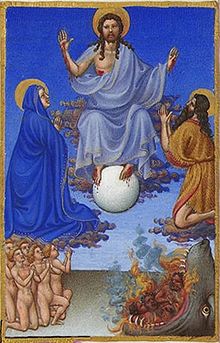ผู้ใช้:Mattis/Articles-Religions

|
กะบะทราย : Sutton Hoo; วิลักษณ์; Valencia {{สั้นมาก}} {{ความหมายอื่น|เกี่ยวกับ= |สำหรับ= |ดูที่=bbb |เปลี่ยนทาง=}} {{ระวังสับสน|bbb}} {{บทความหลัก|xxx}} {{ชื่ออื่น|หัวข้อ|หัวข้ออื่น|บทความ}} {{ใช้ปีคศ|width=290px}} ({{lang-en|aaa}}) {{รายการอ้างอิง}} ในปี ค.ศ. ในปี [[ค.ศ. ]] “XX” “[[XX|XX]]” “''[[XX|XX]]''” |]] () <br>{{spaces|4}} <ref>[]</ref> | etitle=<small>XX</small> Add Thai interwiki '''([http://www.forvo.com/word/aaa#en ออกเสียง])''' [[:Image:aaa.jpg|“aaa”]] “''[[oo|oo]]''”({{lang-th|“''oo''”}}) <!--xx--> |
| ปากนรกภูมิ Hellmouth | |
 “ปากนรกภูมิ” โดยซิมง มาร์มิยอง จาก “Getty Les Visions du chevalier Tondal”, ราว ค.ศ. 1475 |



ปากนรกภูมิ (อังกฤษ: Hellmouth หรือ Mouth of Hell) คือทางเข้าสู่ขุมนรกที่เป็นภาพปากที่อ้ากว้างของยักษาตัวใหญ่ ซึ่งเป็นภาพพจน์ที่เริ่มเขียนกันขึ้นเป็นครั้งแรกในศิลปะแองโกล-แซ็กซอน และต่อมาก็เผยแพร่ไปทั่วยุโรป และเป็นภาพที่นิยมวาดเป็นองค์ประกอบของภาพ “การตัดสินครั้งสุดท้าย” และ “ลงสู่ขุมนรก” (Harrowing of Hell) จนกระทั่งมาถึงปลายยุคกลาง และบางครั้งก็เลยมาจนถึงยุคฟื้นฟูศิลปวิทยาและหลังจากนั้น การเขียน “ปากนรกภูมิ” มาฟื้นฟูกันอีกครั้งในภาพพิมพ์สมัยนิยม (Popular print) หลังการปฏิรูปศาสนาของนิกายโปรเตสแตนต์ เมื่อรูปลักษณ์ของผู้ที่เป็นศัตรูจะเป็นผู้ที่กำลังจะถูกกลืนหายเข้าไปในปาก[1] งานชิ้นสำคัญในสมัยหลังเป็นงานเขียนสองชิ้นของเอลเกรโกที่เขียนราวปี ค.ศ. 1578[2] หรือการ์ตูนล้อการเมืองที่เป็นภาพของจักรพรรดินโปเลียนที่ 1 นำหน้ากองทัพเข้าไปในปาก[3]
การละครของยุคกลางมักจะใช้ปากนรกภูมิเป็นฉาก หรือ เครื่องชัก เพื่อที่จะสร้างความหวั่นกลัวให้แก่ผู้ชม ในการสร้างภาพพจน์อันสยดสยองของทางเข้าสู่ขุมนรก ลักษณะที่สร้างก็มักจะเป็นทางเข้าปราสาทโบราณที่มีเชิงเทิน โดยเพราะเมื่อต้องการที่จะเปรียบเทียบกับสวรรค์[4]
งานชิ้นโบราณที่สุดของปากนรกภูมิที่เป็นปากสัตว์เท่าที่ทราบโดยนักประวัติศาสตร์ศิลป์ชาวอเมริกันเมเยอร์ ชาพิโรเป็นงานสลักงาช้างที่สลักขึ้นราว ค.ศ. 800 (พิพิธภัณฑ์วิคตอเรียและอัลเบิร์ต, ลอนดอน) ชาพิโรกล่าวว่างานส่วนใหญ่ที่สร้างก่อนคริสต์ศตวรรษที่ 12 เป็นงานที่ทำในอังกฤษ ชาพิโรสันนิษฐานว่ารูปลักษณ์ดังกล่าวอาจจะมาจากตำนานปรัมปรา “แครคเดอะดูม” ของเพกัน ที่เป็นปากของหมาป่ายักษ์เฟนเรียร์ ผู้ถูกสังหารโดยวิดาร์ ผู้ใช้สัญลักษณ์ของไครสต์บนกางเขนกอสฟอร์ธ และจากงานศิลปะแองโกล-สแกนดิเนเวียชิ้นอื่นๆ[5] ในการผสานกลืนเข้ากับไวกิงที่ถือคริสต์ศาสนาของประชาชนทางตอนเหนือของอังกฤษ สถาบันศาสนาก็ดูเหมือนพร้อมที่จะยอมรับรูปสัญลักษณ์ที่ใช้ในประเพณีนิยมของท้องถิ่นเข้ามาผสานกับรูปสัญลักษณ์ที่ใช้ในคริสต์ศาสนาโดยมิได้ทำการขัดขวาง เช่นในการใช้หินสลักสำหรับที่หมายหลุมศพแบบไวกิงเป็นต้น ที่กล่าวถึงในวรรณกรรม “เบวูล์ฟ”[6]
In the Anglo-Saxon Vercelli Homilies (4:46-8) Satan is likened to a dragon swallowing the damned:
"... ne cumaþ þa næfre of þæra wyrma seaðe & of þæs dracan ceolan þe is Satan nemned." - "[they] never come out of the pit of snakes and of the throat of the dragon which is called Satan."[7]
The whale-monster Leviathan (translated from Hebrew, Job 41:1, "wreathed animal") has been equated with this description, although this is hard to confirm in the earliest appearances. However in The Whale, an Old English poem from the Exeter Book, the mouth of Hell is compared to a whale's mouth, though somewhat indirectly:
The whale has another trick: when he is hungry, he opens his mouth and a sweet smell comes out. The fish are tricked by the smell and they enter into his mouth. Suddenly the whale’s jaws close. Likewise, any man who lets himself be tricked by a sweet smell and led to sin will go into hell, opened by the devil — if he has followed the pleasures of the body and not those of the spirit. When the devil has brought them to hell, he clashes together the jaws, the gates of hell. No one can get out from them, just as no fish can escape from the mouth of the whale.[8]
Later in the Middle Ages the classical Cerberus also became associated with the image, although it is hardly likely that the Anglo-Saxons had him in mind.[9]
Satan himself is often shown sitting in Hell eating the damned, but according to G.D. Schmidt this is a separate image, and the Hellmouth should not be considered to be the mouth of Satan, although Hofmann is inclined to disagree with this.[10] Equally the Hellmouth never bites the damned, remaining wide open, ready for more.
Another possible archetype for the medieval concept of "hellmouth", is in the book of Numbers, chapter 16, verses 28 through 33. The words there describe a momentary act of God, and not a permanent state of an area of landscape, nor is there any suggestion of an animal mouth, so it is unlikely to have inspired the medieval image:
- And Moses said, "Hereby you shall know that the LORD has sent me to do all these works, and that it has not been of my own accord. If these men die as all men die, or if they are visited by the fate of all mankind, then the LORD has not sent me. But if the LORD creates something new, and the ground opens its mouth and swallows them up with all that belongs to them, and they go down alive into Sheol, then you shall know that these men have despised the LORD." And as soon as he had finished speaking all these words, the ground under them split apart. And the earth opened its mouth and swallowed them up, with their households and all the people who belonged to Korah and all their goods. So they and all that belonged to them went down alive into Sheol, and the earth closed over them, and they perished from the midst of the assembly.
(verses from English Standard Version)
อ้างอิง แก้
- ↑ Example by Cranach, 1545
- ↑ Variously called The Adoration of the Name of Jesus (National Gallery, London)image, The Dream of Philip II or Allegory of the Battle of Lepanto (Escurial).image
- ↑ from first external link
- ↑ The Ecclesiological Society Dooms and the mouth of hell in the late medieval period with pictures including two Renaissance stagings.
- ↑ Meyer Schapiro, "Cain's Jaw-Bone that Did the First Murder", Selected Papers, volume 3, Late Antique, Early Christian and Mediaeval Art, 1980, pp. 257-9 and notes, Chatto & Windus, London, ISBN 0701125144JSTOR
- ↑ The Anglo-Scandinavian Hogback: A Tool for Assimilation
- ↑ Petra Hofmann (thesis)Infernal Imagery in Anglo-Saxon Charters, p. 85, St Andrews, 2008
- ↑ translation by Michael DC Drout
- ↑ Hofmann, 148
- ↑ Hofmann, 85
อ่านเพิ่ม แก้
- G. D. Schmidt, The Iconography of the Mouth of Hell:Eighth-Century Britain to the Fifteenth Century, 1995, Selinsgrove, PA, Susquehanna University Press, 1995, ISBN 0945636695
- Austin Simmons, The Cipherment of the Franks Casket (PDF) Hellmouth (or the whale as constituting Hell) is inferred in the inscription on the front side of the Franks Casket.
ดูเพิ่ม แก้
แหล่งข้อมูลอื่น แก้
วิกิมีเดียคอมมอนส์มีสื่อเกี่ยวกับ ปากนรกภูมิ